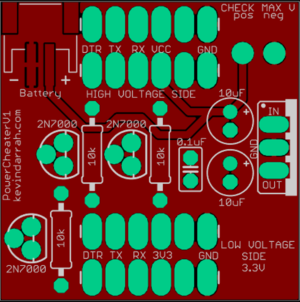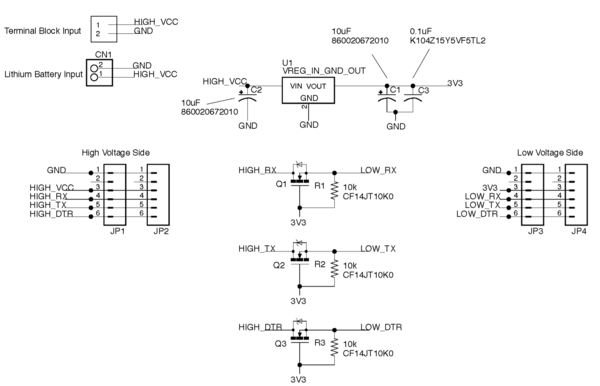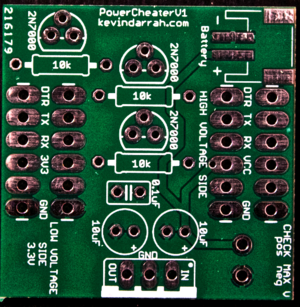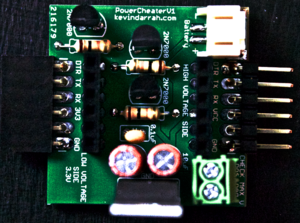Power Cheater
Introduction
The Power Cheater Board provides a simple Level Shifter between a standard USB-Serial Converter from 5V to 3.3V and also serves as a 3.3V linear power supply to the project board. It works nicely with the Cheater Board. Power can be applied to the board from the USB-Serial Converter, Externally through the terminal block, or through a JST connector via a typical Lithium battery.
The inspiration to make this board came from the need for a cheap power supply for the ESP8266 WiFi Module with low quiescent current draw. This video here describes the power supply and benchmarks the regulators that are compatible with this board:
The MOSFET Level Shifters are Explained in this video:
Here's the schematic for reference:
Assembly
The board ships as a bare board like this:
The board can be assembled easily, since it only consists of through hole components, then it looks like this:
then when plugged into the Cheater board using the USB-Serial Converter:

Parts
It is up to you to order the parts. The list can be downloaded **HERE**. This can be directly uploaded into Digikey if you'd like. The parts are pretty self explanatory - make sure that you pay attention to which way the Radio Modules plug into the board. There are markings/text on the board indicating which header each module should be used for.
Pin Out
ESP8266:
- TX from the ESP8266 goes to Arduino Pin 6 - pin 6 would be a Software Serial RX
- RX to the ESP8266 comes from Arduino Pin 7 - pin 7 would be a Software Serial TX
- GPIO 2 is not connected
- GPIO 0 is connected to one of the pushbuttons (under the ESP8266) pulled LOW when pressed - floating when not pressed
- RESET is connected to the other pushbutton (under the NRF24L01+) pulled LOW when pressed
NRF24L01+:
- IRQ is connected to Arduino Pin 2 - Interrupt 0
- CE is connected to Arduino Pin 4
- CSN is connected to Arduino Pin 5
- CLOCK is connected to Arduino Pin 13
- MOSI is connected to Arduino Pin 11
- MISO is connected to Arduino Pin 12
- Note that Arduino Pin 10 will not be useable, since the NRF24L01+ communicates via SPI, thus making the SS (Slave Select) pin not useable - there may be workarounds for this.
Test Code
Coming soon!



